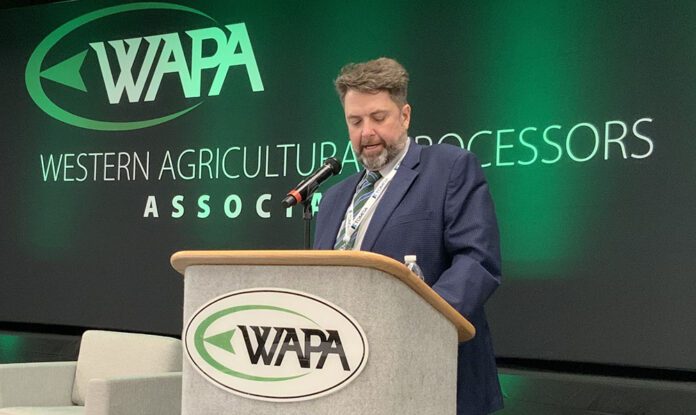
California nut handlers and processors acknowledged the challenging environment in the nut industry over the last couple years at this year’s Western Agricultural Processors Association annual meeting in June,
WAPA staff laid out the regulatory and legislative environment they have been battling to help keep almond, walnut and pistachio processors on steady footing while those handlers and marketers work to stimulate demand and improve efficiencies throughout the supply chain.

Economic Outlook
At the WAPA confefence Roland Fumasi, head of Rabo Research Food and Agribusiness North America, offered a contrast of stabilizing, expansion and contraction for the nut industry but generally held to a more optimistic position.
“Yes, there’s been a lot of pain in the tree nut industry over the last few years, particularly in walnuts and almonds, but things are turning around,” Fumasi said. “As we look at the 2024-25 marketing year and even the next five years, things are going to start to look much more positive.”
The degree of optimism depends on the tree nut. Fumasi said Rabo research shows almonds are in a stabilization period. While some forecasters have argued that there will be hundreds of thousands fewer bearing acres of almonds over the next five years, Fumasi expects it to be much more stable. Pistachios, on the other hand, are expected to continue expanding in production over the next five years, particularly as non-bearing acreage comes into production. Walnuts will likely see a continued pullback in production to tighten supply even more.
“That’s where we see things, but we expect much stronger markets in terms of pricing for all three tree nuts in 2024-25,” Fumasi said.

“In summary, almonds are stabilizing, pistachios are expanding, and walnuts need to pull back on production. We expect stronger pricing for all three tree nuts in the coming years.”
Reflecting on almond grower prices and global production, Fumasi said production levels in California and logistical challenges are stabilizing, which, along with a lowering of interest rates and reduced carryout, should help drive almond demand and prices worldwide.
“The growth in global consumption is expected to get back on track, as is domestic demand as economic conditions improve,” he said.
For pistachios, lower prices in recent years have propelled shipment growth. Domestic consumption growth has been more than 10 percent annually, which should over the next five to ten years. However, average prices might weaken as supply increases.
Walnuts present a different game. Global production has been high, but most walnut consumption is in-country production. China and Chile have been increasing their exports, putting pressure on California walnuts. Despite tighter carryout and reduced production, walnut prices are expected to strengthen, but not enough to make the walnut system whole, Fumasi said.

Food Safety
During the breakfast keynote presentation, James Gorny, senior science advisor for produce safety at the FDA’s Center for Food Safety and Applied Nutrition outlined how the FDA is restructuring under a new office of microbiological food safety to look at reducing the risk of pathogen contamination in the food supply chain.
This will likely result in new ways the industry deals with the federal government on these issues but also improve communication with state agencies and lead to faster decision making and response times. This timely conversation drew interest in light of a recent E. coli outbreak last spring that was linked to organic walnuts. Twelve illnesses had been linked to this outbreak.
In the long term Gorny also discussed the proposed final rule on preharvest ag water that could lead to new reporting requirements for irrigation systems to identify and reduce microbial hazards in the system.
The proposed rule, in the works for the last 10 years, includes new requirements for inspecting and monitoring irrigation water systems and taking action on deficiencies. Gorny said the FDA has received nearly 200 public comments from growers and industry groups encouraging flexibility based on actual risk.

Legislative Roundtable
An annual tradition at the WAPA annual meeting WAPA President and CEO Roger Isom sat down the state legislators who are active in the problem solvers’ caucus to highlight some of the areas where law makers are finding common ground. State Senator Marie Alvarado-Gil and Assemblyman Juan Alanis are examples of two legislators who work across the aisle to find common sense solutions to the complexities in California.
“Our state is so big that one size fits all does not work,” Alanis said. “We think in the middle of the row and look there for solutions.”
One such issue is water supply and protecting surface water supplies from appointed bodies. Alvarado-Gil said it is important growers and handlers put their experiences around water distribution and supply on record.
Similarly appointed boards are driving new mandates around renewable energy that aren’t consistent with reality, Isom said.
To this end, Alanis said, “Has anybody seen a semi-truck charger on the wide of the road? The infrastructure is not there for EV mandates.”
The panel agreed that working together to inject reality into proposed mandates would continue to be an important goal for WAPA and the caucus.















